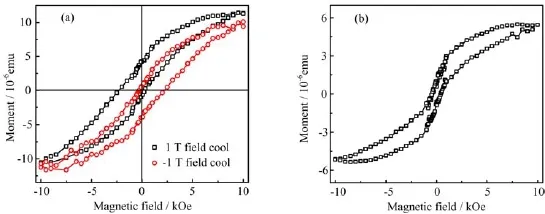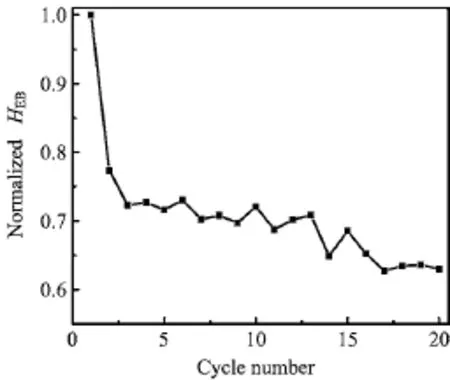Exchange Bias Effect in Phase Separated La0.33Pr0.34Ca0.33MnO3Thin Films
Hui Li,Lin Li,Long Cheng,Hai-xing Liang,Chang-gan Zeng
Hefei National Laboratory for Physical Sciences at the Microscale and Department of Physics,University of Science and Technology of China,Hefei 230026,China
Exchange Bias Effect in Phase Separated La0.33Pr0.34Ca0.33MnO3Thin Films
Hui Li,Lin Li,Long Cheng,Hai-xing Liang,Chang-gan Zeng?
Hefei National Laboratory for Physical Sciences at the Microscale and Department of Physics,University of Science and Technology of China,Hefei 230026,China
Exchange bias effect is observed in the phase separated La0.33Pr0.34Ca0.33MnO3thin f i lms. High exchange bias field of about 1 kOe is achieved at 4 K.The exchange bias effect in La0.33Pr0.34Ca0.33MnO3thin f i lms might originate from the intrinsic phase separation of the La0.33Pr0.34Ca0.33MnO3or surface effect.The dependence of exchange bias effect on temperature,cooling field,and thickness is also investigated.This work would open an avenue to the application in the magnetic memory devices based on the phase separated manganites.
Exchange bias,Phase separation,Pulse laser deposition,Manganites,Training effect
I.INTRODUCTION
Exchange bias(EB)effect has attracted intensive research attention due to its potential application in magnetic memory devices[1-3].The typical characteristics of the EB effect is a shift in the magnetic hysteresis loop away from zero field after being cooled through the Neel temperature of the antiferromagnet in the presence of an applied magnetic field[4-6].The occurrence of EB effect is due to the exchange interaction between antiferromagnetic(AFM)material and ferromagnetic(FM) material at their interface[4].The EB effect has been widely studied in different coupled systems,such as FM/AFM heterostructures,FM/ferrimagnetic bilayers systems,and FM/spin glass systems[7-11].Recently, EB effect has also been observed in perovskite manganites and cobalites with intrinsic electronic phase separation[12-17].The interaction between the AFM phase and FM phase or spin glass phase in the phase separated manganites and cobalites gives rise to the EB effect.
(La,Pr,Ca)MnO3has been proven to be a typical phase separated manganites,in which the AFM chargeordered insulating(COI)phase and FM metallic phase coexist at submicron meter scale[18,19].EB effect can in principle be observed in(La,Pr,Ca)MnO3systems with large scale phase separation.However, current research on the EB effect in the phase separated manganites is mainly focused on the manganites nanoparticles or nanowires systems,the EB effect on the(La,Pr,Ca)MnO3f i lms are rarely studied[20-22].
In this work,we study the observation of the EB effect on La0.33Pr0.34Ca0.33MnO3(LPCMO)thin f i lms. Evident EB effect with the EB field of about 1 kOe was achieved at 4 K in the 8 nm LPCMO thin f i lms. Temperature,cooling field,and thickness dependent EB effect was also revealed in phase separated LPCMO thin f i lms.The investigation on the EB effect in (La,Pr,Ca)MnO3f i lms not only explores the possibility of(La,Pr,Ca)MnO3f i lms as a candidate for technological application,but also helps us to understand the complex correlation coupling between FM and AFM phase.
II.EXPERIMENTS
Epitaxial LPCMO thin fi lms with di ff erent thickness were grown on LaAlO3(001)substrates by pulsed laser deposition using a KrF excimer laser at a repetition rate of 3 Hz and laser energy density of 5.5 J/cm2. The growth temperature and the oxygen pressure were 700°C and 40 Pa,respectively.After the fi lm growth, the fi lms were postannealed at the same deposition condition for half an hour,and subsequently annealed at 780°C in fl owing O2for 5 h to reduce the amount of oxygen vacancies.The magnetic measurements were carried out using the superconducting quantum interference device(SQUID)magnetometer.The magnetic fi eld was applied parallelly to the fi lm plane.
III.RESULTS AND DISCUSSION
Magnetization hysteresis curves for the 8 nm LPCMO thin f i lms measured at 4 K are presented in Fig.1.In strong contrast to symmetric reversal of the magnetization in the zero field cooling(ZFC)process(Fig.1(b)),the center of the magnetic hysteresis curves is shifted after being cooled in an external magnetic fi eld of ±10 kOe.The shift direction of the hysteresis curves is opposite to the applied cooling fi eld.The shift of the magnetic hysteresis curves is known as EB,and the EB fi eld was de fi ned to be the magnitude of the center shift from zero,

FIG.1 (a)Magnetic hysteresis curves at 4 K for 8 nm LPCMO thin f i lms after being field cooled from 300 K in 1 T and -1 T field.(b)Magnetic hysteresis curve at 4 K for the same LPCMO thin f i lm after being zero field cooled from 300 K.

where HC1and HC2are the coercive fi eld of forward and reversed branch of the hysteresis loop,respectively [4-6].The EB fi eld for the 8 nm LPCMO thin fi lms is estimated to 1.039 and 0.969 kOe for the positive-and negative- fi eld cooling process,respectively.Such a high EB fi eld has never been observed in the phase separated LPCMO thin fi lms.
Figure 2 shows the EB fi eld(HEB)as a function of temperature for the 8 nm LPCMO thin fi lms.The temperature dependent HEBwas measured after being fi eld cooled in 10 kOe to the certain temperature from 250 K (Fig.2(a)).With the increase of temperature,the EB fi eld decreases,and almost disappears above the blocking temperature Tb≈40 K(Fig.2(b)).In the phase separated manganites,the magnetic moment is frozen below the blocking temperature,and the frozen phase is regarded as the FM metallic phase and the AFM charge ordered insulating phase in LPCMO[23,24].As the LPCMO thin fi lms fi eld cooling through Tb,a frozen interfacial exchange coupling between the FM metallic phase and AFM charge ordered insulating phase would be induced and result in the occurrence of the EB.However,when the temperature is higher than Tb,the spin of the FM cluster cannot be frozen e ff ectively,and the EB e ff ect disappears accordingly[21,25].
The cooling fi eld dependent HEBwas measured at 4 K,as seen in Fig.3,HEBundergoes a nonlinear change,rapidly increase when the cooling fi eld is lower than 10 kOe and decrease with the cooling fi eld increasing further.At a low cooling fi eld,the increase of the cooling fi eld will align spins collinearly to the external magnetic fi eld direction,resulting in the increase of the magnetic coupling between the interface of the FM cluster and AFM cluster,and consequently the increase of the EB fi eld.With further increasing of the cooling fi led,the size of FM cluster increases as well.Analogous to the case of the FM/AFM thin fi lms system,according to the Bean’s equation,the EB fi eld decreases while the FM layer thickness increases[4].The decrease of the EB fi eld at the high cooling fi eld might be relatedto the increase of size of the FM cluster.

FIG.4 Normalized HEBfor 8 nm LPCMO thin f i lms as a function of the number of cycles at 4 K after being field cooled in 10 kOe.
The training e ff ect of the LPCMO thin fi lms was also investigated at 4 K after being cooled from 250 K in 10 kOe(Fig.4).The value of HEBrapidly decreases after the fi rst cycle,and is roughly decreased with the increase of the measured cycles with some fl uctuations in the subsequent cycles.The decrease of HEBwith increase of the cycles due to the relaxation of the interface spin con fi guration is in accordance with the previous studies[12,20].During the consecutive fi eld cycles, the spin direction of the AFM cluster surface might be changed,which would result in a decreased exchange coupling at FM cluster and AFM cluster.Therefore,a decreased EB e ff ect can be observed in the consecutive fi eld cycles.
The EB e ff ect on the phase separated LPCMO thin fi lms may be due to the coexistence of the FM cluster and AFM cluster at the low temperature,or due to the surface e ff ect of the thin fi lms.It has been revealed the coexistence of the FM cluster and AFM cluster in the LPCMO thin fi lms by adopting magnetic force microscopy[19,26],optical conductivity[27],etc. The interfacial exchange coupling interaction between AFM cluster and FM cluster would result in the EB e ff ect.It is noted that the EB e ff ect was also observed in La0.67Sr0.33MnO3f i lms with thickness below 3 unit cell[17],and Pr0.7Ca0.3MnO3f i lm[13].On the other hand,the surface effect becomes dominant when the size of the materials is reduced to nanoscale.However, the inf l uence of the surface effect on the EB effect of the phase separated LPCMO thin f i lms still needs more effort to clarify.

FIG.5 Thickness dependent of HEBat 4 K for LPCMO thin f i lms after being field cooled and zero field cooled from 300 K.
Thickness dependent EB effect on the LPCMO f i lms was also investigated.As seen in Fig.5,the EB effect could only be observed for the LPCMO f i lms with thickness below 12 nm.The thickness dependent EB effect could be interpreted in terms of phase separation between FM and AFM in LPCMO f i lms.With the increase of thickness,the FM interaction is enhanced. The FM region increases at the expense of AFM region, resulting in a weaker AFM anisotropy[17].When the AFM anisotropy is reduced weakly to bias FM region at the interface,EB effect can no longer been observed.
IV.CONCLUSION
EB e ff ect is revealed in the phase separated LPCMO thin fi lms,and the high exchange bias fi eld of about 1 kOe is achieved at 4 K in 8 nm LPCMO thin fi lms. The EB e ff ect in the LPCMO thin fi lms shows strong dependence on the temperature,cooling fi eld and thickness.The origin of the EB e ff ect in the LPCMO thin fi lms is also investigated,which may be due to the intrinsic electronic phase separation or the surface e ff ect. This work open a new way for the application of the phase separated manganites in the technological application.
V.ACKNOWLEDGEMENTS
This work was supported by the National Natural Science Foundation of China(No.11374279 and No.11034006),theNationalBasicResearchProgram of China(No.2014CB921102),the Strategic Pri-ority Research Program of the Chinese Academy of Sciences(No.XDB01020000),the Specialized Research Fund for the Doctoral Program of Higher Education(No.20113402110046),and the FundamentalResearchFundsfortheCentralUniversities (No.WK2340000035).
[1]J.Nogu′es,J.Sort,V.Langlais,V.Skumryev,S. Suri?nach,J.S.Mu?noz,and M.D.Bar′o,Phys.Rep. 422,65(2005).
[2]S.A.McEnroe,B.Carter-Stiglitz,R.J.Harrison,P. Robinson,K.Fabian,and C.McCammon,Nat.Nano 2,631(2007).
[3]S.M.Zhou,L.Shi,H.P.Yang,Y.Wang,L.F.He,and J.Y.Zhao,Appl.Phys.Lett.93,182509(2008).
[4]W.H.Meiklejohn and C.P.Bean,Phys.Rev.102,1413 (1956).
[5]J.Nogues and I.K.Schuller,J.Magn.Magn.Mater. 192,203(1999).
[6]M.Kiwi,J.Magn.Magn.Mater.234,584(2001).
[7]B.Martinez,X.Obradors,L.Balcells,A.Rouanet,and C.Monty,Phys.Rev.Lett.80,181(1998).
[8]M.Ali,P.Adie,C.H.Marrows,D.Greig,B.J.Hickey, and R.L.Stamps,Nat.Mater.6,70(2007).
[9]S.M.Wu,S.A.Cybart,P.Yu,M.D.Rossell,J.X. Zhang,R.Ramesh,and R.C.Dynes,Nat.Mater.9, 756(2010).
[10]D.Tripathy,A.O.Adeyeye,K.Chakrabarti,and N. Singh,J.Appl.Phys.107,09D705(2010).
[11]M.Gibert,P.Zubko,R.Scherwitzl,J.Iniguez,and J. M.Triscone,Nat.Mater.11,195(2012).
[12]D.Niebieskikwiat and M.Salamon,Phys.Rev.B 72, 174422(2005).
[13]Y.K.Tang,Y.Sun,and Z.H.Cheng,J.Appl.Phys. 100,023914(2006).
[14]Y.H.Sun,Y.G.Zhao,H.F.Tian,C.M.Xiong,B.T. Xie,M.H.Zhu,S.Park,W.D.Wu,and J.Q.Li,Phys. Rev.B 78,024412(2008).
[15]Y.Zhang,Z.Zhang,and J.Aarts,Phys.Rev.B 79, 224422(2009).
[16]B.G.Kim,A.Kumar,S.Ki,S.Kim,and J.Dho,J. Appl.Phys.110,123907(2011).
[17]Y.J.Shi,Y.Zhou,H.F.Ding,F.M.Zhang,L.Pi,Y. H.Zhang,and D.Wu,Appl.Phys.Lett.101,122409 (2012).
[18]M.Uehara,S.Mori,C.H.Chen,and S.W.Cheong, Nature 399,560(1999).
[19]L.Zhang,C.Israel,A.Biswas,R.L.Greene,and A.de Lozanne,Science 298,805(2002).
[20]T.Qian,G.Li,T.Zhang,T.F.Zhou,X.Q.Xiang,X. W.Kang,and X.G.Li,Appl.Phys.Lett.90,012503 (2007).
[21]S.K.Giri,A.Poddar,and T.K.Nath,AIP Adv.1, 032110(2011).
[22]S.K.Giri,S.M.Yusuf,M.D.Mukadam,and T.K. Nath,J.Appl.Phys.115,093906(2014).
[23]L.Ghivelder and F.Parisi,Phys.Rev.B 71,184425 (2005).
[24]L.Li,H.Li,X.Zhai,and C.Zeng,Appl.Phys.Lett. 103,113101(2013).
[25]W.G.Huang,X.Q.Zhang,H.F.Du,R.F.Yang,Y. K.Tang,Y.Sun,and Z.H.Cheng,J.Phys.:Condens. Matter 20,445209(2008).
[26]R.Rawat,P.Kushwaha,D.K.Mishra,and V.G.Sathe, Phys.Rev.B 87,064412(2013).
[27]H.Lee,K.Kim,M.Kim,T.Noh,B.Kim,T.Koo,S. W.Cheong,Y.Wang,and X.Wei,Phys.Rev.B 65, 115118(2002).
ceived on April 26,2014;Accepted on May 14,2014)
?Author to whom correspondence should be addressed.E-mail:cgzeng@ustc.edu.cn,Tel.:+86-551-63602463
 CHINESE JOURNAL OF CHEMICAL PHYSICS2014年4期
CHINESE JOURNAL OF CHEMICAL PHYSICS2014年4期
- CHINESE JOURNAL OF CHEMICAL PHYSICS的其它文章
- Elasticity and Thermodynamic Properties of EuS Related to Phase Transition
- Corrosion Study on Tantalum in Anhydrous Ethanol
- Kinetics Study on O2Adsorption and OHadDesorption at Pt(111),Its Implication to Oxygen Reduction Reaction Kinetics
- Phase Transition Behaviour of VO2Nanorods
- Effect of Molybdenum Doping on Oxygen Permeation Properties and Chemical Stability of SrCo0.8Fe0.2O3-δ
- Preparation of TiO2/Bi2O3Microf i bers and Their Photocatalytic Activity
